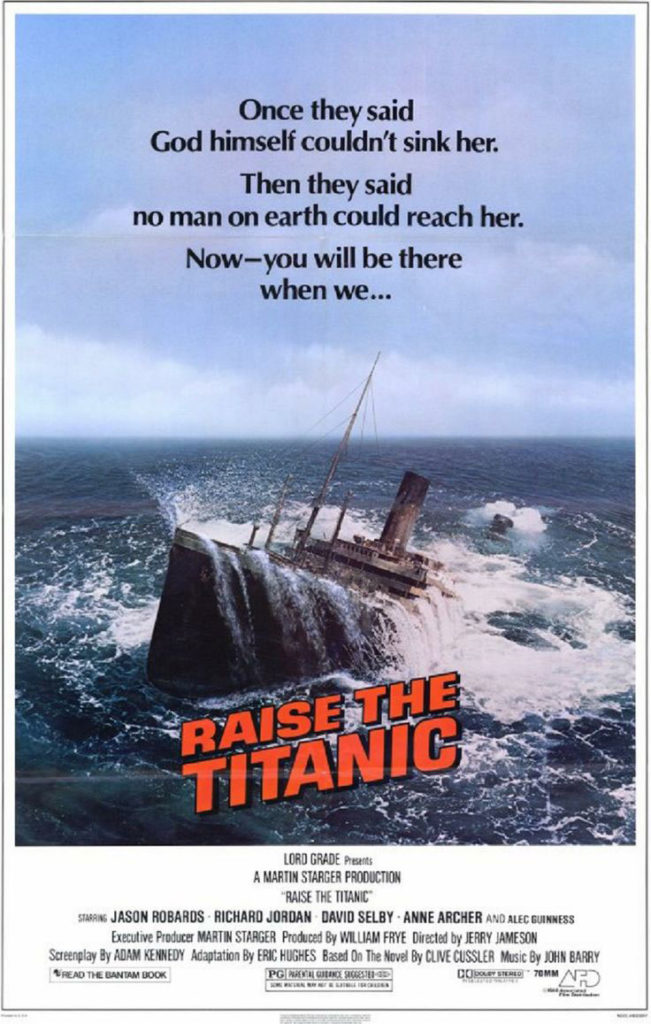Schlock on such a grandiose scale as Raise the Titanic only comes about on rare occasions. As such, it should be treasured, albeit briefly, until the novelty wears off. Raise the Titanic not only tells the story of an attempt to salvage the famous shipwreck, it is also a Cold War tale of epic proportions, the outcome of which would determine the balance of power in the world. In the cargo hold of the sunken ship lies the only known supply of a rare mineral, byzanium, capable of powering a laser shield that can disable all nuclear missiles heading for the United States. I am not making any of this up. This was the plot of an actual movie.
Released in 1980, Raise the Titanic is notable not just for its outlandish story, but also for being a colossal flop. It cost a heap of money to produce and didn’t make a quarter of it back at the box office. Of course, box office receipts do not tell a person the true value of this, or any movie. They are mere symptoms of the diseases that plague them. What doomed Raise the Titanic wasn’t the ridiculous plot, either. That was working. Rather, it committed the most deadly sin of all in film: it was boring.
Things begin all right, if outlandishly. Opening above the Arctic Circle, we are introduced to protagonist Dirk Pitt (Richard Jordan), a freelance operative occasionally hired by the United States Navy to carry out its most dangerous, and secret, tasks. Dirk Pitt rescues another American operative who has tracked down the mine where the byzanium was extracted, but who was also was attacked and injured by a Soviet soldier. No byzanium is to be found, until after some major story acrobatics point to the cargo hold of the Titanic, and that is when the fateful decision is made. Raise the Titanic! Instead of just, you know, cutting it open on the sea floor and grabbing what they were looking for there, rather  than raise a 43,000 ton ship off the floor of the ocean that, in the words of Dirk Pitt, “...never knew how to do anything but sink.” This task would be so much easier, as well, since an eyewitness from back then told them exactly where the byzanium was located in the cargo hold. Minor detail! The movie is called Raise the Titanic and that is exactly what they will do. However, once the salvage mission begins, the movie slows to a crawl and never lets up.
than raise a 43,000 ton ship off the floor of the ocean that, in the words of Dirk Pitt, “...never knew how to do anything but sink.” This task would be so much easier, as well, since an eyewitness from back then told them exactly where the byzanium was located in the cargo hold. Minor detail! The movie is called Raise the Titanic and that is exactly what they will do. However, once the salvage mission begins, the movie slows to a crawl and never lets up.
Most of that has to do with setting. The Titanic is sitting over two miles down on the ocean floor. It’s dark down there, it’s cold, and the water pressure is so great it took engineers about 45,000 years of maritime history to solve. The submarines that can reach such depths are tiny and don’t move all that fast. There’s a lot of slow pans across a darkened screen, models drifting almost listlessly, and shots of submarine crews cramped and stuffed together like sardines. The director, Jerry Jameson, knew this was happening, because he sacrifices a couple pawns in an attempt to shoot some tension into the middle of the movie. It didn’t work. It’s kind of odd, but up until the point where they begin exploring the ocean depths, the wildness of the story was what drove it. As soon as they got in the water, though, the movie was weighed down by its sense of realism. Only the impossible nature of the task remains from the freewheeling first act. Other than that, we get to hear about crush depth and two hour descents from the surface. Good God, just light this candle and bring the ship up, immediately, before the audience hangs itself. Which is exactly what Jameson did, sensing, once again, that the movie was dangerously mired in a somnambulistic pace.
So up the Titanic comes (don’t pretend this is a spoiler), and Jameson milks it for all it is worth. I didn’t break out a stopwatch, but if it didn’t take at least five minutes for the ship to break the surface, it felt like it did.
Oh, there was also some serious talent present in this movie. Besides Jordan, Jason Robards has a substantial role as Dirk Pitt’s superior, Admiral James Sandecker, USN (Ret.). And look quickly early on in the movie. That’s Alec Guiness as a Titanic survivor, regaling Dirk Pitt with tales of the sinking and introducing him to pink gin. Finally, on the regular talent scale, there’s Anne Archer as intrepid reporter Dana Seagram, who disappears from the movie with lightning speed when someone figured out the movie didn’t need her character at all. As a side note, this is the second movie in a row I have reviewed that features Latvian actor Elya Baskin in a supporting role, here playing an aide to a bigwig from the Soviet Embassy. Nothing significant here, just one of those little coincidences that crop up occasionally.
The final verdict on Raise the Titanic was tough. Finally, though, I have to go with Alien: Resurrection as the better movie. That second act in Raise the Titanic was just lethal. I think it slowed my heart rate down. Up until then, however, it had Sigourney and Winona on the ropes. Up until then it was a good shitty movie, then it just died.
